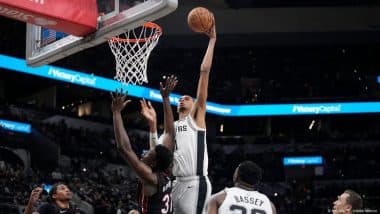Thrombosis is treacherous. Basketball superstar Victor Wembanyama had to take months off because of it. DW explains why even top athletes are not immune to the condition.Whether France's basketball superstar Victor Wembanyama will be able to take part in the European Championships at the end of August 2025 is still up in the air. The 21-year-old, who plays in the NBA for the San Antonio Spurs, has been out of action since the end of February due to thrombosis in his right shoulder. He underwent shoulder surgery in March. "I would like to do more, but I have to listen to the doctors," says Wembanyama. After all, thrombosis is no joke.
Former NBA player and Hall of Fame star Chris Bosh had to end his career due to thrombosis. Tennis icon Serena Williams also suffered blood clots several times during her active career. In 2011, she had to undergo emergency surgery due to a pulmonary embolism. Three-time world handball player of the year Mikkel Hansen from Denmark and Nikola Karabatic from France also had to be treated for the same condition. And in the Bundesliga in 2016, Neven Subotic, at Borussia Dortmund at the time, was ruled out for the second half of the season due to a vein thrombosis in his arm.
Also Read | Chicago Fire Leading MLS Race To Sign Manchester City Star Kevin De Bruyne: Reports.
"Plenty of exercise is an important part of preventing thrombosis, but there are also other risk factors," says sports physician Pascal Bauer. "Athletes are only human and can therefore get all the diseases that affect others."
Bauer heads the departments of Sports Cardiology, Cardiovascular Prevention and Vascular Diseases at the University of Giessen. Last year, he looked after and advised almost 400 professional athletes.
What is thrombosis?
Thrombosis is the Greek word for clot or lump. Thrombosis is when a blood clot forms in a blood vessel, for example a vein or artery, blocking the vessel and thus obstructing the blood flow. Every thrombosis is an emergency. Vascular occlusions in the deep leg and pelvic veins are particularly dangerous. If part of the blood clot becomes detached, it can enter the lungs via the heart and block veins that are vital for breathing. This is known as a pulmonary embolism.
"It can vary in severity - from ‘I feel a bit short of breath or nothing at all' to death," says vascular expert Bauer. The larger the detached blood clot, the more dangerous it becomes. The Thrombosis Action Alliance estimates that between 40,000 and 100,000 people die from pulmonary embolisms in Germany every year. According to United Nations estimates, one in four deaths worldwide is associated with thrombosis.
Are there any sports that are particularly at risk?
"There is a slightly increased risk in sports that involve the upper body and where you repeatedly make the same arm movements," explains Bauer, citing ice hockey, handball, basketball, volleyball, baseball and tennis as examples.
"The athletes develop a lot of muscle mass, which can lead to the already narrow shoulder area, where arteries, veins and nerves snake through, becoming even narrower. The weakest link is the veins. If they are repeatedly compressed, endothelial damage [cell damage on the inside of the vein] can occur, resulting in thrombosis."
Thrombosis can also occur in contact sports such as football, where the risk of injury to the legs is higher due to fouls, among other things. The same applies to long-distance running, where there is a risk of micro-injuries to the legs.
According to Bauer, there is a higher risk for professionals of all sports if they frequently travel long distances to their competitions and therefore spend a lot of time on the bus or plane. There is then a risk of stasis: the blood stagnates, increasing the risk of thrombosis.
What alarm signals indicate a thrombosis?
"Classic leg vein thrombosis begins with a one-sided swelling of the lower leg, with pain, a feeling of heat and often a bluish-purple discoloration and visible veins in the shin area," says Bauer.
The person initially experiences a feeling of tension, then a pressing pain, "as if the arm is bursting from the inside," says Bauer. Another characteristic feature is a network of veins that often forms on the surface of the skin in the shoulder area, "a bypass circuit because the deeper vein is blocked."
In contact sports in particular, there is a risk that athletes mistake the alarm signals of thrombosis for normal symptoms of injuries or sore muscles.
What can athletes do to prevent possible thrombosis?
"The most important things are preventive sports examinations and good training hygiene," replies Bauer. "Athletes should make sure they drink enough. What they sweat out must be returned to the body so that the blood doesn't thicken. Secondly, they must remember to move their legs when traveling," adds Bauer. "Athletes should always listen to their own bodies."
It may also be advisable to wear compression stockings on long flights or bus journeys. Doping, with anabolic steroids or EPO for example, also increases the risk of thrombosis.
How is thrombosis diagnosed and treated?
It is diagnosed using a combination of blood analysis and imaging techniques. A special blood test is used to determine whether there has been major blood clotting in the body. Ultrasound, CT scans or MRIs can be used to detect thrombosis in blood vessels and organs as well as even the smallest blood clots. As a rule, the patient is then given a blood-thinning medication - over a period of three to six months until the thrombosis has disappeared.
After a while, athletes are allowed to train carefully again, but not in competition mode. "The risk of bleeding from injuries is significantly increased by the medication," explains Bauer. "If, for example, a handball goalkeeper gets hit in the head with a ball and suffers a bleed in the head, this can have very serious consequences. Therefore, the need for blood-thinning medication can prevent an athlete from competing in contact sports, even if they are already feeling well again."
After vein thrombosis in the arm, some athletes undergo surgery in the shoulder area. The top rib is shortened so that the vein has more space and does not constantly bump against the rib and become compressed during overhead movements.
This article was originally published in German.
(The above story first appeared on LatestLY on May 02, 2025 02:20 PM IST. For more news and updates on politics, world, sports, entertainment and lifestyle, log on to our website latestly.com).













 Quickly
Quickly


















